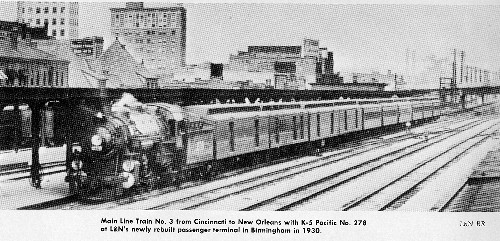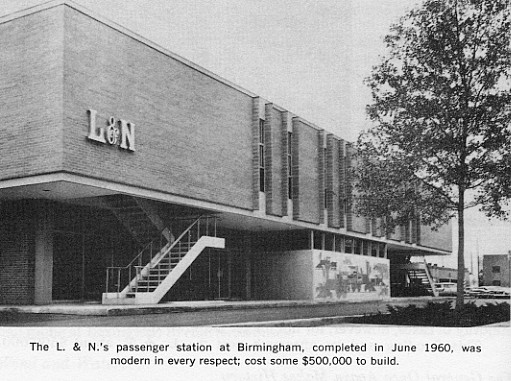More on L & N Station
One of the things about this web page is that it grows with the different items learned. It is created one subject at a time, and there is often considerable time between new articles.
The L & N station has been this sort of learning experience for the author.
Here is what I believe I understand about it's development:
-
The earliest station located adjacent to the Relay House hotel -- this was a crude frame structure
-
First station built in Birmingham at 20th Street, about 1886, along Morris Avenue. All facilities at grade level. Large train shed spanning 5 tracks is located adjacent to the station, parallel to Morris Avenue. L & N yards and shops are located immediately west of this area.
-
Another station built, Birmingham Terminal Station, 1907, which serves all roads except the L & N which elects to stay at original site, alongside L & N main line. Shops move to "old" Boyles Yard in north Birmingham about this time.
-
After 1907, increasing vehicle traffic on surface streets causes increasing congestion, accidents and public debate about need to build "grade separation" in downtown Birmingham.
-
City staff develops a plan, by City Engineer Kirkpatrick and staff, prior to 1920 for a series of viaducts over the tracks and "subways" to carry streets under the tracks. The plan requires raising the elevation of the railroad tracks and is strongly resisted by the railroads: L & N, Southern and Alabama Great Southern. Part of the issue is the sharing of cost between the railroads and the City. Kirkpatrick apparently retired about 1920 and is replaced by City Engineer A. J. Hawkins, who continues as an advocate of the Kirkpatrick plan.
-
The City seeks enabling legislation to allow the City to pass an ordinance requiring the railroads to build grade separations as soon as the City passes an ordinance relating to a specific site. The notion is that the City, through its "police power" has the authority to compel the railroads when the "public health and safety" requires an improvement to be made. The legislature passes the enabling act, and the City responds with ordinances. The railroads do not acquiesce, and the matter is debated hotly in the press, experts are called in and ultimately the matter goes to court.
-
The City prevails on most issues at court, prevails further in the State Appeals court, and then the matter goes to the Alabama State Supreme Court. The City loses.
-
Ultimately the matter is settled and construction is begun in general accordance with the City's original plan, in October, 1928. Cost sharing is to be 50% City and 50% split among 3 railroads.
-
Construction of the "grade separation" is completed in the summer of 1933, as noted in the Railway Age article in this website. The construction requires the removal of the L & N train shed, but not the station building.
| In this 1930 image, published in Herr's, The Louisville and Nashville Railroad, 1853-1963, we see a train using the new elevated passenger platforms. In the very right of the picture, the temporary transition grade, used during the elevation of tracks, is visible, but not very clear. The roof of the 1886 station building is clearly visible above the "umbrella shed" station platform. |  |
-
The station building remains standing at the corner of 20th Street and Morris Avenue -- this is the 1886 station.
-
In the location of the former train shed, there are now elevated tracks, retaining walls, and a new "concourse" located between the station building and the elevated tracks.
-
In addition, there is a new facility constructed beneath the track level of the newly elevated tracks. All of this is in place by the end of 1933. The station remains, and passengers as well as baggage and other activities utilize "subways" or tunnels plus stairs to get to track level, now located above the street level.
|
|
|
|
|
|
|
This view is cropped from a postcard, mailed in the 1940's. The 1886 station building clearly shows, as well as the 1933 "concourse" roof, which is shown in green. The elevated tracks are in place, and the two "umbrella sheds" are shown as nearly white, since the roofs were cast-place-concrete. The passenger cars show as dark green. |
|
|
|
|
-
In 1960, a new L & N station building replaces the 1886 structure. At this time, it is believed that the 1886 building was razed, the concourse was removed (actually a roof structure, some 500 feet long) and a two new buildings are built: the Birmingham Bank for Savings building, and a new L & N station.
-
At the same time, the City builds one more underpass, this time for 19th Street, adjacent to the new buildings noted above. This underpass opens in 1962.
|
This picture is from Herr's book, cited above. It is located on the site of the western end of the original station complex, just on the west side of 19th Street, south of Morris Avenue.
This picture then is likely taken standing in the intersection of 19th and Morris, looking south and west. The Eighteenth Street underpass opening is in the very background, above the tops of the cars. |
 |
-
After 1960, the story is still not clear to the author:
-
When did the 1960 building stop being used?
-
When did the current ticket and waiting room become the only facility serving passengers?
-
What year did L & N stop providing passenger service?
-
What year did Amtrak begin serving Birmingham?
-
